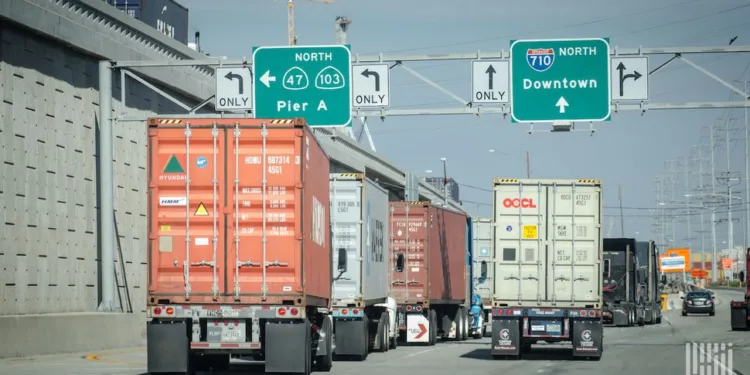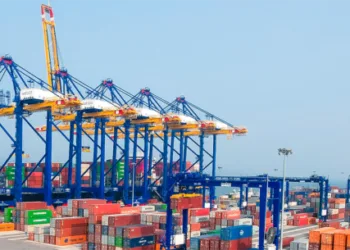Record-setting container volumes failed to flummox local trucking at the Ports of Los Angeles and Long Beach in July.
The busiest U.S. import gateway complex said marine terminal fluidity remained stable, with relatively low dwell times for both truck and rail cargo in the face of surging frontloaded volumes and tariff-twisted fluctuations in seaport traffic.
Local truck dwell averaged 2.87 days, solidly within this past year’s range of 2.55 to 3.25 days, according to monthly data compiled by the Pacific Merchant Shipping Association. That compared favorably with the average of 2.81 days in July 2024, “and continues to reflect adequate trucking capacity and efficient coordination between terminal operators, drayage providers, and cargo owners,” the PMSA said.
The numbers bear out commentary earlier this year by Port of Los Angeles Executive Director Gene Seroka, who said that his port had capacity to spare even during a run-up in container volume.
July rail-bound cargo dwell averaged 5.18 days, slightly below the year-ago average of 5.66 days, and well below peak dwell times over the past year and during the height of supply chain congestion. It’s also on par with April and May 2025, “indicating that rail cargo continues to move at a manageable pace through the nation’s busiest port complex, despite the volumes of container cargo contributing to the record-setting July surge.”
That’s also significant as overall U.S. rail intermodal volume has run consistently ahead of 2024. Union Pacific (NYSE: UNP) and BNSF handle around six of every 10 import containers arriving at West Coast ports; for CSX (NASDAQ: CSX) and Norfolk Southern (NYSE: NSC) that number drops to four out of 10 out of East Coast ports.
“In July, the Port of Los Angeles had its busiest month ever and the Port of Long Beach had its third busiest month ever, but even with these unprecedented surges and shifting cargo patterns, the San Pedro Bay marine terminals continue to demonstrate operational resilience,” said Natasha Villa, PMSA external affairs manager, in a release. “The ability to maintain steady truck dwell times and manage rail flows during these periods of significant change just underscores the strength of collaboration among marine terminals, railroads, and trucking partners at our critical seaports.”
Find more articles by Stuart Chirls here.
Related coverage:
Xeneta expands into global carrier performance with eeSea acquisition
Is Canada Post too big to fail?
Past is prologue: Rising container volumes portend falling rates
Panic? What panic? Port of Los Angeles sees record 1 million containers in July
The post Key LA-Long Beach truck, rail metrics unfazed by record container surge appeared first on FreightWaves.




















